25 Points: Universal Harvester
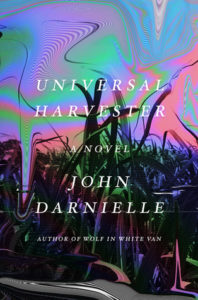 Universal Harvester
Universal Harvester
by John Darnielle
Farrar, Straus and Giroux, 2014
224 pages / $13.21 buy from Amazon
1. I have not yet read Wolf in White Van, (but I hear good things). I also have not read (Black Sabbath’s) Master of Reality, (but I also hear good things).
2. Universal Harvester. The cover is pretty dope-looking. (Plus, it’s sorta cool that advance reader copies came in a VHS case). It totally vibes with my anodized rainbow finish razor. (That’s 2 for 2 Darnielle, tho, I am not actually counting Master of Reality).
3. But hear me out. I want to get this out of the way, like, right away: the book is marketed as horror and perhaps maybe even a little bit mystery. It’s none of these things, really. Or rather, the story isn’t horror in the way you’d expect it to be horror. And it’s also not mystery, in the classic sense of the word, mystery. It’s a little bit of both, and then some.
4. I’m not taking points away from the book either, because of this, no. It’s not Mr. Darnielle’s fault. Rather, he did this on purpose, and I applaud him (in a way) because of these things—Darnielle is trying to do something new & interesting here and, as you might expect, the average reader is not going to be so into that (I’m guessing). (Maybe the not-so-average reader, as well). The narrative is sort of non-linear (so be prepared for that).
5. I must confess, tho, to what intrigued me initially—what made me want to read the book as soon as possible—the story takes place in Iowa (I got my BA from a school in Iowa, this is no secret; and actually, the town where I went to school is mentioned, pretty early on). Also, the fact that it has something to do with VHS culture and film. (I have never seen The Poughkeepsie Tapes but the idea of VHS tapes and weird things happening on VHS tapes made me think of this film, for whatever reason).
6. I also tend to enjoy most things taking place during a time when the VHS market is / was still booming. READ MORE >
March 8th, 2017 / 6:05 pm
25 Points: Sprezzatura
 |
Sprezzatura
by Mike Young
Publishing Genius Press, 2014
132 pages / $14.95 buy from Publishing Genius
|
1. Deep down he thinks he’s too much of a redneck to have got into Husker Du.
2. Syntax 1: His syntax is fascinating. Someone – can’t remember who – once said that ‘a poem should be a machine for re-reading’ and that’s what you do here. You read, you skate across the surface and then you re-read and it’s different the next time and you can’t get bored.
3. Syntax 2: Because of this, it sometimes seems like he’s put a real long scroll of paper into a typewriter emulator and just kept on Benzedrine-typing until he was finished.
4. Don’t get carried away with the Benzedrine though. There’s something else going on here:
“Often I throw a tennis ball against the wall and hope
the people downstairs believe more people exist
above them than really do…”
There’s a bit of craft at work here. Don’t get carried away with the Benzedrine. This isn’t just typing.
5. ‘On the bus, I pass through unobtainable wi-fi’ might be one of the best lines I’ve heard to sum up now, right now.
6. There are things here in this book. Things everywhere. Nouns.
7. There are unfashionable adjectives with fashionable nouns and fashionable nouns with unfashionable adjectives everywhere here.
8. Mike Young is a poetic phrase-maker in a way you don’t see too much in contemporary literature/Alt-Lit etc. He’s bringing phrase making back and making it cool.
9. I want to make a phrase now but you know you can’t just make a phrase just out of the blue as easy as you might think, it’s hard. If you plan it too much and try to think of a noun and an adjective and put them together the only noun you end up thinking of it ‘sea’ and the only adjective is ‘blue’ (or if you’re feeling revolutionary ‘green’) and that was all well and good 700 years ago but now it’s just some blue or green sea that isn’t even good enough for a corporate advertising slogan advertising shower gel let alone a book of writing/poems. So, it’s hard making phrases. It’s an art form. It’s easier to consciously make a bad one. This book is full of none-bad phrases. Here’s some:
10. ‘…imported mango soda’
October 20th, 2014 / 12:09 pm
25 Points: The Pedestrians
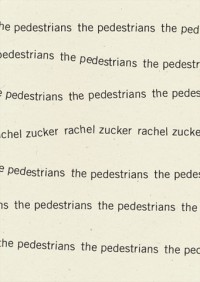 |
The Pedestrians
by Rachel Zucker
Wave Books, 2014
160 pages / $18.00 buy from Wave Books
|
1. The ‘Once upon a time…’-style tone of the beginning of this book reminded me of the short story ‘Clay’ in James Joyce’s Dubliners and what he or someone called the ‘marmaladey-drawersey’ tone it was written in.
2. I really like the phrase ‘sublet bed.’ Sublet properties and the whole poetry of the rented house concept are so often commented on but not sublet beds. Hurray for this.
3. To return to the style and tone for a moment, if we may…(hey that was really formal for a moment wasn’t it, cool) I really like what I’m going to call the circumlocutory descriptions here such as ‘She had a small copper wire inside her. This made conception highly unlikely.’ when she could have said ‘coil’ or ‘intrauterine contraceptive device.’ This starkness really makes me laugh for some reason. In England, there used to be books called ‘Janet and John’ books for small children that used this kind of tone to help the kids learn how to read. They didn’t mention coils or IUCDs but I really think that style transplanted to adult life is cool.
4. ‘Every day she watched the UPS truck come toward her up the/road, make a three-point turn into the driveway before hers,/and pull away’
This is beautiful, man. I can’t say more about it than that.
5. ‘They had not known each other when they were teenagers but/when the radio with the human genome played Phil Collins it/was 1985 bar mitzvah season all over again.’
I have no idea what a radio with a human genome is but the imagery is fantastic that’s just my point I suppose, that’s just my point about this book, the imagery is delicious throughout.
6. Such juxtapositions. Babysitters, Buddhist monks and pole dancing competitions. The world and this book are full of such juxtapositions.
7. Another reviewer worried about this book. They worried about how the main character who lived in the most expensive city in the world (New York) and had trips to Paris and an apparently idyllic bourgeois life with husband and children and so on and yet complained all the time. They worried how this might be taken perhaps. Whilst my own working class proletariat background could go probing into this with my bullshit-detector, instead I was reminded of DFW and his thoughts on his, albeit slightly earlier, generation and how despite all the opulence everyone was still so lonely and miserable and how much of an interesting question this still is (even now the middle-classes have discovered Occupy in their gap year).
8. I’m defending it but it’s ok to worry about that too, I think it’s a valid point. Marxism is one of the better lines of enquiry for me.
9. I have a real affection for the poem called ‘Real Poem’ because it neatly and concisely parodies Poetry (that’s poetry with a capital P) and all its big profundity and arrogance.
10. Reminds me I haven’t had babies yet.
October 17th, 2014 / 12:00 pm
25 Points: Ozma of Oz
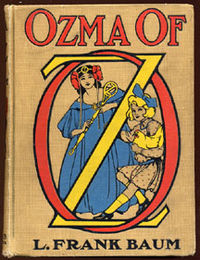 |
Ozma of Oz
by L. Frank Baum
HarperCollins, 1989
272 pages / $6.95 buy from Amazon
|
1. This past year, my 5-year-old has been obsessed with me reading The Wizard of Oz to her over and over and over. While I have loved that book for decades, I reveal to her it is a series – there are more!
2. So we begin book two in the Oz series, The Marvelous Land of Oz. Which turns out to not be marvelous. “Where is Dorothy?” my daughter asks. In fact, Dorothy is nowhere to be found. Instead of Dorothy, there is a sorceress who is trying to force her ward Tip to drink a potion that will turn him into a statue. The sorceress is kind of scary.
3. Though the sorceress is not why we stop reading the book.
4. We stop reading when the ridiculous all-girl Army of Revolt storms the Emerald City, making the men mind the children and do the housework, only to get scared off by mice.
5. We move onto Treasure Island which I realize, early on, is not appropriate for a 5-year-old because of large quantities of murder and rum, finally settling upon Pippi Longstocking which, despite the heroine’s coffee habit and dead parents, appears a good fit. Then it is back to The Wizard of Oz.
6. Then instead of rereading The Wizard of Oz again, I suggest why don’t we try book three in the series (Ozma of Oz). The book is #83 on the School Library Journal’s list of the best children’s novels ever. Unsurprisingly, The Marvelous Land of Oz is not on the list. Still, I am nervous, making my daughter nervous. Reading bad books is an awful experience, but reading bad books aloud to your child is much worse, as it takes longer and skimming is difficult to do.
7. In the case of Ozma of Oz, There was no need to be nervous. It turns out I love this book. I have loved this book. This is the book with the lunch-box tree. “The tree seemed to bear all the year around, for there were lunch-box blossoms on some of the branches, and on others tiny little lunch-boxes that were as yet quite green, and evidently not fit to eat until they had brown bigger. The leaves of this tree were all paper napkins, and it presented a very pleasing appearance to the hungry little girl.” Inside the lunch-box was, “nicely wrapped in white papers, a ham sandwich, a piece of sponge-cake, a pickle, a slice of new cheese and an apple. Each thing had a separate stem, and so had to be picked off the side of the box…”
8. But the tin dinner-pail tree is even better. The dinner-pails grew on another tree and inside each pail was a thermos of lemonade, plus “three slices of turkey, two slices of cold tongue, some lobster salad, four slices of bread and butter, a small custard pie, an orange and nine large strawberries, and some nuts and raisins. Singularly enough, the nuts in this dinner-pail grew already cracked, so that Dorothy had no trouble in picking out their meats to eat.” I remember these trees. These trees are one of the most vivid memories of reading I can recall as a child.
9. I think it was a tragedy of extreme proportions to the child-me that such trees were nowhere to be seen in my Chicagoland home. The lack of such trees was proof that there had been some mistake and that I was living in the wrong world.
10. This is also the book with Princess Langwidere who has a room full of velvet lined cupboards and, inside each cabinet, is a different head that she can put on or take off whenever she likes. Unfortunately, when Dorothy is visiting, the princess puts on the mean head.
October 15th, 2014 / 12:58 pm
25 Points: If I Really Wanted to Feel Happy I’d Feel Happy Already
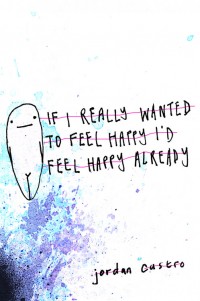 |
If I Really Wanted to Feel Happy I’d Feel Happy Already
by Jordan Castro
Civil Coping Mechanisms, 2014
162 pages / $13.95 buy from Amazon
|
1. This book and it being read by me results in me saying that Jordan Castro is like a really cool stand-up comedian sometimes.
2. A thoughtful, off-beat, occasionally philosophical stand-up comedian who plays to small audiences of people who are ‘in the know’ but could sell out bigger shows but perhaps wouldn’t want too but might think about it a little bit but wouldn’t want too.
3. The title is another one of those fucking ace, long titles isn’t it. Have you read it (see above)? Good isn’t it. Becoming something of a tradition isn’t it – the long, good, title.
4. Castro is…no, no I’m not going to call him that. Not going to just call him by his surname like they do in reviews. It feels a bit like a teacher talking about a pupil or a factory owner (A factory owner? Fuck! What century am I in?) talking about a worker in a slightly patronising way. So, yeah. Jordan Castro is a fan of circular reasoning, it pops up throughout the book. He gets all circulus in probando (Wikipedia) on our ass all the time.
5. Or maybe he’s not a fan of circular reasoning. Maybe these things trap him and impede his life like they do with all of our lives and he finds it’s best to try and write about them to circumvent this trap slightly and if we read him we can slightly circumvent our own circular traps. Just slightly. I don’t think he’s trying to write a miracle cure.
6. This book isn’t a miracle cure. Never believe in miracle cures. They don’t exist. They’re all scams. This book isn’t a scam. This book is upfront about things, about everything that’s going on in the minutiae of everyday life. It’s not a miracle cure but it might help. Plus it’s really funny and entertaining too, which helps.
7. The tale of a character named ‘Sarah’ that starts on p.95 is the tale of everyone nowadays who is under 40 and many over 40 and soon everyone in the western world and later everyone in every other type of world (this latter depends on a few things that are currently, to put it politely, ‘in flux’ in global affairs) but they won’t all be named Sarah.
8. In this one:’got a lot of allergies/been thinking about literature/for maybe five hours’, he’s secretly thinking about the sounds of words at the end of lines like an old fashioned poet but is hiding it even though he’s made it really subtle and really good.
9. Pages 115-119 make me realise that social media is so bedded-in in America that people really do view it as part of their real identity and really do agonise about what statuses they type and how they’ll be perceived and how many ‘Likes’, ‘Comments’, ‘Notes’ or whatever it will/should get in a way that is only really just starting to happen in the UK and in a way which sometimes depresses them.
10. I read somewhere in an interview with Noah Cicero (it could’ve been from ages ago, he might have changed his opinion by now, I don’t know. Anyway, he’s entitled to his opinion) that he didn’t really rate David Foster Wallace as being too much to do with Alt-Lit type of stuff but point number 9 makes me want everyone to read this essay by David Foster Wallace on television and then for someone else, someone who is still alive, and someone who, like me, doesn’t have to work full-time to re-write that essay, updating it for today’s social media landscape and for us all to see how prescient it was in the first place.
October 13th, 2014 / 12:00 pm
25 Points: Gamine
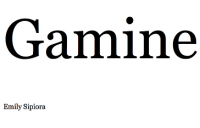 |
Gamine
by Emily Sipiora
forthcoming from Pink Finger Press, 2014
|
1. This book often has a cut-up and and collage kind of feel and sometimes reminds me of Jean Luc Godard’s ‘Pierrot le Fou’ in a way that I can’t fully explain.
2. I don’t really like rhyme or half-rhyme and some of this is rhymed and half-rhymed but somehow it manages to avoid that cloying feeling that rhyme and half-rhyme gives to too much poetry. This is an achievement because most who attempt this don’t manage to accomplish it so well.
3. She’s also doing something with meter, I think, which is brave if so (I haven’t scanned it properly obviously – partly cos scanning is so subjective and party because I didn’t want to). I gave up meter myself, I didn’t like how it mangled my syntax, same with rhyme and the need for a lot of what more traditional poetry bods call masculine endings (stressed syllables at the end of a line). Maybe this type of stuff is due a return. I don’t know. Emily pulls it off pretty well, though.
4. Elliott Smith is a welcome presence in anything that I experience and he pops up here. Sometimes directly quoted and sometimes in bit like ‘Mr Amiability’ (although while I was writing this my girlfriend was asking me to put the HDMI on the TV and it made me think how Elliott Smith could’ve even sung HDMI and made it sound amazingly melancholic. I know the writer likes him and I think he’s a good person to like which is contrary to the way in which a British tabloid recently managed to somehow implicate him from way beyond the grave in the death of British celebrity Peaches Geldolf. After seeing his legacy trotted out in such ridiculously absurdist tabloid terms, it’s nice to have him back and rehabilitated into something real and artistic and appropriate.
5. Ian Curtis pops up now. He joins Elliott Smith. There’s a theme here.
6. “Anyone up at 3am was either in love or lonely” is a great line.
7. “I live in your voicemail now” another great line.
8. There are a lot of great lines here.
9. This author is pretty young, like 17 or 18 or something, I think. This isn’t her first book which is pretty impressive in itself. I was going to say she’s ‘pretty mature for her age’ until I realised it made me sound like an old ageing aunt or something. Maybe this is how it is these days but if she’s getting this kind of thing out there now already, what can we expect in years to come? I’m looking forward to it, whatever it is. All you other Alt-Lit writers, you’re getting old, man! (That was a joke mostly on myself, to be fair).
10. There’s stuff in here that is kind of cut-up image macros of Wikipedia. I read somewhere that someone ‘advised’ Emily to stop putting photos in her books because it makes it seem more like a blog. I think she should put whatever she likes in and perhaps this person maybe hasn’t been looking to closely at the alternative literary scene of the past 5-8 years.
October 9th, 2014 / 12:00 pm
25 Points: Sorrow Arrow
 |
Sorrow Arrow
by Emily Kendal Frey
Octopus Books, 2014
92 pages / $12.00 buy from Octopus Books
|
1. I read Sorrow Arrow in June.
2. “What was the last book you read/what was your favourite, lately?” A friend of mine who was out of town for the summer sent me this text message. I told her it was Sorrow Arrow by Emily Kendal Frey. When she got back into town a few months later I loaned it to her.
3. If you’re like me, once a year or so, you read a book that makes you rethink the way you’ve been writing entirely and you come away from it sure beyond a shadow of a doubt that the only way to write is the way that writer does it.
4. Sorrow Arrow was one of those books. When I was finished with it I just felt the entirety of all the poetry I’d ever written pass into obsolescence.
5. My first exposure to Emily Kendal Frey was when we both had prose poems published in Issue 6 of Banango Street in January. I felt privately certain they only published my poem because it was a prose poem roughly the same length as hers and together the two felt like they were kin somehow — cousins of about the same age who look just like each other but only met for the first time in their late teens. Hers was the more successful cousin by far.
6. I added her on Facebook and a few weeks later she posted as a status the sentence “She is born!” and the book’s cover, a faceless blankness wrapped in a green wreath, whirling, encircling sheaves of grass.
7. Two weeks later she posted that the book was available for order and I ordered it immediately.
8. Here is one of the poems: “A radiation plume is making its way to us/We write it down so we won’t think/Lap dogs sprinkled with acid snow/I got on the plane and sat back/Out the window I regretted complaining/I’m sorry I wasn’t able to get inside your color/The sky was cobalt, deafening/I die so I can live/Outside category” (p. 57)
9. At the centre of Sorrow Arrow is a tragedy. There is a tragedy at the centre of every great book of poetry, I imagine.
10. Frey’s tragedy runs through the poems—none of which have titles—like a skein of gold, a vein you can see just beneath the skin, a tungsten wire that glows bright and hot to the touch.
October 6th, 2014 / 12:00 pm
25 Points: Matt Meets Vik
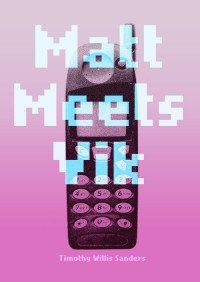 |
Matt Meets Vik
by Timothy Willis Sanders
Civil Coping Mechanisms, 2014
164 pages / $13.95 buy from Amazon
|
Or ‘Rich Meets Vik’ to review ‘Matt Meets Vik’ as Richard Brammer teams up with his girlfriend ‘Vik’ (Victoria Brown) to review this book.
1. Vik: At the end of the book, I didn’t expect it to be the end and kept turning (scrolling) the pages thinking there would be another chapter. When I realised that it was the end I was pleased at the way it ended.
2. Vik: I’m a woman so I don’t often get to hear a man’s raw thoughts. I liked that this book put me in the position to see male thoughts. I assume that they are real-ish male thoughts.
3. Rich: Shit! I haven’t started reading the book yet. I’m going to read it and find out. I’m not sure but I think I have real-ish male thoughts to compare them to, as a scientific control.
4. Vik: The book is set when Snake was a big deal on Nokia phones. I never had a Nokia, but I remember the enthusiasm Nokia owners had for Snake.
5. Rich: I had one of those Nokia’s. Before that I had a Nokia 5410 or something (in about ’95 and this was before my impoverished dispersed family had a house phone even). I loved Snake though. I was as addicted to Snake as I could’ve been to anything 2-dimensional at that time. I used to commentate to myself about my own performance on Snake like it was a sport and I was a great renowned competitor.
6. Vik: Actually I did have a Nokia phone but it was such an early Nokia that it didn’t allow you to access your address book when typing a text message so you would have to memorise the phone number of the person you wanted to text when texting. Which was terrible.
7. Rich: Shit! There’d be v apathetic riots if technology was designed like that now. My first phone had a text facility but the network ‘didn’t support it’. Should we review this book now?
8. Vik: I read this book in about 4 sittings; it is 177 pages long. I read it really quickly.
9. Vik: I’m a woman named Vik but I didn’t identify that much with the character named Vik, in fact I identified as much with the character named Matt as I did with Vik.
10. Vik: There are other characters, Chantelle, Ralph, Lucas and Esme and maybe some more.
October 2nd, 2014 / 12:00 pm
25 Points: Wolf in White Van
 |
Wolf in White Van
by John Darnielle
Farrar, Straus and Giroux, 2014
224 pages / $24.00 buy from Amazon
|
1. I don’t like writing. The actual act of writing, I mean. It’s hard to get started. Just getting this first of twenty-five points written took longer than the next twenty-four.
2. I like better having written, when there’s a mess of text on the page to play with. It’s not really creating anymore at that point; it’s discovery, exploring. Moving around in it and finding what I might have missed the first time.
3. John Darnielle’s Wolf in White Van is a book about a lot of things. Mostly, though, it’s about exactly this kind of discovery and exploring that appeals to me. Discovery through text, exploring between your ears. Imagined mountains, dreamt-up spaces.
4. “It gets so lonely living inside your own head,” writes the narrator, as way of explanation for having dreamt up one particularly dangerous space. The book centers on this hero’s reasons for—and the consequences of—dreaming up a game called Trace Italian.
5. Trace Italian is a by-mail role-playing game of sorts. “The way you play Trace Italian,” the narrator tells us, “seems unbearably quaint from a modern perspective, and people usually don’t believe me when I tell them it’s how I supplement my monthly insurance checks, but people underestimate just how starved everybody is for some magic pathway back into childhood.”
6. “A magic pathway back into childhood” is a better way of describing what this book is about. Memory, remembering. Finding the path back to a place where anything is possible.
7. It’s just the kind of book I like best.
8. I’m so glad this book isn’t called Trace Italian.
9. The “monthly insurance” checks the narrator mentions in point 5 above are part of the mystery of the book. What exactly happened that led this person to create a game and collect insurance checks? What caused him to live sequestered from the world? Why does he order swords from a catalog? Real, honest-to-god swords?
10. Players begin Trace Italian by sending an SASE to a PO Box and receiving in turn a sheet of paper telling them where they are in the imagined world. It’s a post-event world of sorts; they must traverse a landscape toward an end goal, the Trace, where they’ll find safety from the bad things that have taken over.
September 30th, 2014 / 2:50 pm
25 Points: Mother of a Machine Gun
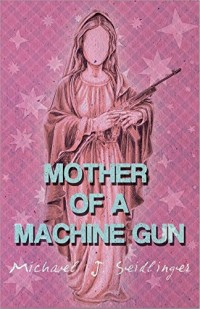 |
Mother of a Machine Gun
by Michael J. Seidlinger
Lazy Fascist Press, 2014
100 pages / $7.95 buy from Amazon
|
1. When I first read the title, I pondered the possibility of an automatic weapon being successfully birthed from a woman’s vagina. (Pretty sure your genitalia would never be the same.)
2. The writing style of Mother of a Machine Gun reminded me of some strange Dr. Seuss book I read as a child.
3. Michael J. Seidlinger is a fucked up Dr. Seuss.
4. Kind of wonder if Seidlinger’s mother has read Mother of a Machine Gun and whether or not she thought it should be “critically acclaimed.”
5. Pondered the economic and environmental costs of having so many one-line paragraphs.
6. To go along with point #5, probably should’ve put in pictures or something to fill in the vast amount of white space.
7. To go along with points #5 and #6, the vast amount of white space and one-line paragraphs make for a quick read. (Could be a positive or negative thing depending on whether or not you like the book.)
8. Mother of a Machine Gun is a story of denial.
9. Mother sucks at being a mother.
10. Mother probably shouldn’t be left to go on a crusade to find her son.
September 25th, 2014 / 4:30 pm
